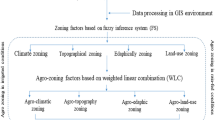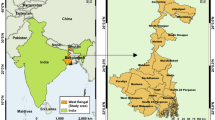Abstract
Conventional methods of delineating farming-pastoral ecotones were not quantitative and could not fully show their spatial distribution. The present paper attempts to develop quantitative methods for mapping farming-pastoral ecotones in China. Nine indicators, related to temperature, precipitation and altitude aspects, were selected to quantify ecological susceptibility of vegetation (crops and forage). Methods of analytic hierarchy process (AHP) and expert score ranking combined with fuzzy set theory were applied to assign the weight for each indicator and to define the membership functions. The geographic information system (GIS) was used to manage the spatial database and conduct the spatial analysis. According to the spatial calculation of evaluation model integrated with GIS, the ecological susceptibility of vegetation (crops and forage) was mapped. Three different zones, pastoral area, farming-pastoral ecotones and farming area, were classified by spatial cluster analysis and the maximum likelihood classification for the numeric map of vegetation ecological susceptibility by GIS. This map was validated by the economic statistical result based on the ratio of the output value from animal husbandry in total output value of agriculture by the National Bureau of Statistics in China, indicating that the mapping of the farming-pastoral ecotones may be accepted.
Similar content being viewed by others
References
Aguilar-Lasserre A.A, Bautista M. A., Ponsich A., González Huerta M.A. 2009. An AHP-based Decision-making Tool for the Solution of Multiproduct Batch Plant Design Problem Under Imprecise Demand. Computers and Operations Research 36(3): 711–736.
Arnot C., Fisher P. 2007. Mapping the Ecotone with Fuzzy Sets. In: Morris A., Kokhan S. Geographic Uncertainty in Environmental Security. Dordrecht, Netherlands: Springer. Pp.19–32.
Bawa K. S., Joseph G., Setty S. 2007. Poverty, Biodiversity and Institutions in Forest-agriculture Ecotones in the Western Ghats and Eastern Himalaya Ranges of India. Agriculture, Ecosystems & Environment 121(3): 287–295.
Boroushaki S., Malczewski J. 2008. Implementing an Extension of the Analytical Hierarchy Process Using Ordered Weighted Averaging Operators with Fuzzy Quantifiers in ArcGIS. Computers & Geosciences 34(4): 399–410.
Buxbaum C. A., Vanderbilt K. 2007. Soil Heterogeneity and the Distribution of Desert and Steppe Plant Species Across a Desert-grassland Ecotone. Journal of Arid Environments 69(4): 617–632.
Chabot B. F., Mooney H.A. 1985. Physiological Ecology of North American Plant Communities. New York, USA: Chapman & Hall. Pp. 351
Chan F. T. Jiang B., Tang N. K. 2000. The Development of Intelligent Decision Support Tools to Aid the Design of Flexible Manufacturing Systems. International Journal of Production Economics 65(1): 73–84.
Corona P., Chirici G., Davide T. 2004. Forest Ecotone Survey by Line Intersect Sampling. Canadian Journal of Forest Research-Revue Canadienne De Recherche Forestiere 34(8): 1776–1783.
ESRI. 2006. ARCGIS 9.2 Desktop Help.
Fagan W. F., Cantrell R.S., Cosner C. 1999. How Habitat Edges Change Species Interactions. The American Naturalist 2(153): 165–182.
Fortin M. J., Olson R. J., Ferson S., Iverson, L., Hunsaker C., Edwards G., Levine D., Butera K., Klemas V. 2000. Issues Related to the Detection of Boundaries. Landscape Ecology 15(5): 453–466.
Han J. G., Sun Q. Z., Ma C. H. 2004. The Sustainable Development of Agriculture and Animal Husbandry Technology in Farming-pastoral Zone. Beijing: Chemical industry Press. Pp. 8–11. (In Chinese)
Ho W. 2008. Integrated Analytic Hierarchy Process and its Applications-A Literature Review. European Journal of Operational Research 186(1): 211–228.
Holland M. M., Risser P. G., 1991. Introduction: the Role of Landscape Boundaries in the Management and Restoration of Changing Environments. In: Holland, M. M., Risser, P.G., Naiman, R.J. (Eds.), Ecotones: The Role of Landscape Boundaries in the Management and Restoration of Changing Environments. New York, USA: Chapman & Hall. Pp. 1–10
Hou X. Y. 2001. Change Pattern, Process and Landscape Ecological Significance in Ecotone of Agriculture and Grassland in North China. Chinese Journal of Eco-Agriculture 9(1): 1–73. (In Chinese)
Hu H. Y. 1935. Chinese Population Distribution. Acta Geographica Sinica, 2: 36–77
Li D. L., Lu L. Z. 2002. Climate Characters and Evolution of Agricultural and Pasturing Interlaced Zone in China. Journal of Desert Research 22(5): 483–488. (In Chinese)
Lidicker W. Z. 1999. Responses of Mammals to Habitat Edges: an Overview. Landscape Ecology 14: 333–343.
Mu, X. D. 1997: Grassland Systems Engineering. Beijing: Chinese Agricultural Press. Pp. 76–78, 326–327 (In Chinese)
Peterson D. W. Reich P. B. 2008. Fire Frequency and Tree Canopy Structure Influence Plant Species Diversity in a Forest-grassland Ecotone. Plant Ecology 194(1): 5–16.
Pogue D. W., Schnell G. D. 2001. Effects of Agriculture on Habitat Complexity in a Prairie- forest Ecotone in the Southern Great Plains of North America. Agriculture, Ecosystems & Environment 87: 287–298
Ries L., Fletcher R. J., Battin J., Sisk T. D. 2004. Ecological Responses to Habitat Edges: Mechanisms, Models, and Variability Explained, Annual Review of Ecology Evolution and Systematics 35: 491–522.
Saaty T. L. 1977. A scaling Method for Priorities in Hierarchical Structures. Journal of Math. Psychology 15: 234–281.
Saaty T. L., Hu G. 1998. Ranking by Eigenvector Versus Other Methods in the Analytic Hierarchy Process. Applied Mathematics Letters 11(4): 121–125.
Saaty T.L. 1980. The Analytic Hierarchy Process. New York, USA: McGraw-Hill. Pp. 287
Sarkar S., Kanungo D., Patra A. K., Pushpendra K. 2008. GIS Based Spatial Data Analysis for Landslide Susceptibility Mapping. Journal of Mountain Science 5(1): 52–62.
Vaidya O.S., Kumar S. 2006. Analytic Hierarchy Process: An Overview of Applications. European Journal of Operational Research 169(1): 1–29
Vassilios K., Klaus-Peter T., Ruth M. 2002. Application of System Dynamics and Fuzzy Logic to Forecasting of Municipal Solid Waste. Mathematics and Computers in Simulation 60: 149–158
Wang W. X., Li Y. M., Li Z. Z., Yang F. X. 2003. A Fuzzy Description on Some Ecological Concept. Ecological Modelling 169(2–3): 361–366.
Wang Y. M., Luo Y., Hua Z. S. 2008. On the Extent Analysis Method for Fuzzy AHP and its Applications. European Journal of Operational Research 186(2): 735–747.
Zadeh L. A. 1965. Fuzzy sets. Information and Control 8: 338–353
Zhao S. Q. 1953. The Economic Geographic Survey of A Transition Zone Between Cropping Area and Nomadic Area in Northern Chahar, Chahar League and Xilin Gol League. Acta Geographica Sinica 19(1): 43–60. (In Chinese)
Zhu G. L., Shan L., Liu G. B. 2004. Ways of Plant Cover Recovery in Agriculture-Pasture Cross Bedding Area on the Loess Plateau. China Water Resources 8: 30–32. (In Chinese)
Author information
Authors and Affiliations
Corresponding author
Rights and permissions
About this article
Cite this article
Zhang, J., Wei, J. & Chen, Q. Mapping the farming-pastoral ecotones in China. J. Mt. Sci. 6, 78–87 (2009). https://doi.org/10.1007/s11629-009-0221-5
Received:
Accepted:
Published:
Issue Date:
DOI: https://doi.org/10.1007/s11629-009-0221-5




